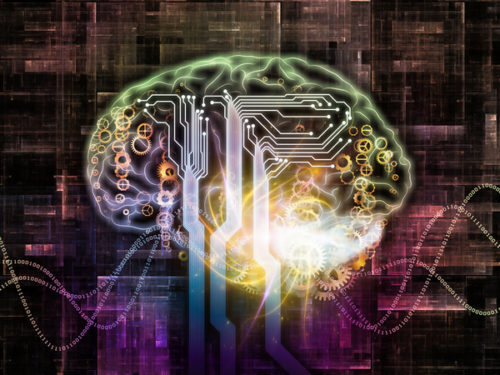Brain’s Memory Circuits
Brain vs. computer
Are analogies of brain to computer reasonable? The dry systems used by computers are trillions of times faster than the wet ware system used by brain. Yet, brains almost instantly carry out extraordinary feats of problem solving and environmental analysis. We all know what happens when computers encounter an error. They stop! In contrast, the human brain uses a slow and error prone system to create thoughts, an understanding of its data. The human brain’s slowness and imperfection is its ultimate edge for creativity.
Brain electricity
How does brain electricity differ from household electricity? Electrical current and electrical circuits have different meaning to electrical engineers and neuroscientists. To electrical engineers, current is the movement of charged particles through an immobile system called a circuit. Computers use this kind of current. Electrical circuits defined by electrical engineers are paths consisting of a closed loop through which current flows. In an electric circuit the charged particles always end up back at their source when they complete their path.
In the brain, current flow refers to a serial shift in the voltage difference across a neuron’s cell membrane rather than a flow of charged particles from the cell body to the synaptic terminals. The fluctuating membrane voltage called an action potential occurs because of charged ions that flow out of and into the neuron. Action potentials are electrical in nature. And action potentials do progress along a path through the brain. But the charged particles responsible for the current are not themselves moving the length of the axon.
Brain circuits consist of linked neurons. Connections between neurons are mobile and the circuit configuration is subject to modification. Connections between neurons experience constant readjustment based upon the quantity and quality of incoming signals. Brain circuits are not closed loops where charged particles end up back at their source when they complete their circuit.
Brain synapses
Information is processed in computers by simple ‘on’ and ‘off’ signals flowing through uninterrupted circuits. Information processing schemes used by the brain are far more complex because there are physical breaks between the wiring components (neurons) called synapses.
There are no hard and fast rules for information transfer at neuron synapses. Transfer of brain electrical activity across synapses occurs by a chemical process. The chemical process is graded and variable. There are many components to brain synapses that add to this variability. Individual synaptic structures may enhance or impede transfer of an electrical signal to the next neuron in a circuit.
For example, astrocytes surround many brain synapses and it is their job to quickly remove the chemical called a neurotransmitter from a synaptic cleft. Additional incoming signals are not recognized when the synaptic cleft remains saturated with neurotransmitter.
In addition to physical breaks in brain circuits there are also functional restraints on brain circuits. Functional control of electrical flow in brain is created by little neurons called interneurons. Interneurons are so small that it is hard to tell the difference between their dendrites and axons. Most interneurons increase polarization of the charge across pre- and post-synaptic membranes. Such hyperpolarization of pre- and postsynaptic membranes blocks the spread of signals from neuron to neuron.
Brain information processing
Early studies based upon the signaling patterns of sensory neurons of the retina and other sensory organs led investigators to theorize that brain neurons also coded information by strings of ‘on’ and ‘off’ signals. It was believed that information was coded either by the rate of action potentials or by the time between action potentials. Acquiring hard data to distinguish between the importance of the rate vs. the number of events was difficult because individual neurons display a background action potential rate that is equivalent to noise.
Newer data suggest that brain neurons never code alone. Rather brain action potential coding is carried out by groups of neurons responding to similar input. This is called ensemble coding. The model assumes that ensemble coding works better because noise of individual neurons is cancelled out.
There is also evidence for recruitment of neurons from reserve pools to core ensemble circuits. The reserve pool neurons share input and output circuits with the core ensemble but release a different neurotransmitter than the core group. Such flexible composition of neuron ensembles allows graded output in response to incoming signals.
The future may bring computers that work much like the human brain. But technology will first have to advance far enough to discover how the brain’s neuron slow, imperfect circuits actually create awareness, understanding, memory and responses to a shifting environment.
Brain networks
Neurons of the brain connect to form large scale functional networks. These networks are identified by the functions they serve. Brain hubs facilitate the functionality of the anatomically separate circuits. Several such networks have been identified in the human brain so far using imaging techniques. One, the default mode is active when a person is awake and at rest. Another, the dorsal attention mode is involved in attention to unexpected events. The lateral visual network is important in dealing with complex emotions. These are just a few of the many such networks scientists are detailing with their research.
To simplify, it helps to think of brain hubs like airline hub cities connected by flight paths. When flying from one part of the globe to another there are many ways to get there through different hub cities. When thinking there are many ways to get from one idea to another.
Yet, neuroscience is still a long way from knowing all of what goes on inside the closed world of the brain. What is becoming clear however is that when it comes to brains vs. computers, brains will lead in creativity for the future. Here is a YouTube video of a TED talk by Dr. Henning Beck titled ‘What is thought? How the brain creates new ideas’.
Do you have comments or questions?
Do you think robots will ever be able to think like humans? Please put your thoughts on this subject in the comment box or send me an email at DrReece@MedicalScienceNavigator.com. I read and reply to all comments and email.
If you think this description of information coding in the brain is helpful, share it with your fellow students or send it to your favorite social media by clicking one of the buttons below.
Further Reading:
Neuron’s Where Does Their Electricity Come From?
Astrocytes and Energy in the Brain
Margaret Thompson Reece PhD, physiologist, former Senior Scientist and Laboratory Director at academic medical centers in California, New York and Massachusetts is now Manager at Reece Biomedical Consulting LLC.
She taught physiology for over 30 years to undergraduate and graduate students, at two- and four-year colleges, in the classroom and in the research laboratory. Her books “Physiology: Custom-Designed Chemistry”, “Inside the Closed World of the Brain”, and her online course “30-Day Challenge: Craft Your Plan for Learning Physiology”, and “Busy Student’s Anatomy & Physiology Study Journal” are created for those planning a career in healthcare. More about her books is available at https://www.amazon.com/author/margaretreece. You may contact Dr. Reece at DrReece@MedicalScienceNavigator.com, or on LinkedIn.
Dr. Reece offers a free 30 minute “how-to-get-started” phone conference to students struggling with human anatomy and physiology. Schedule an appointment by email at DrReece@MedicalScienceNavigator.com.




Pingback:Mom Brain – Scholarly Mommy